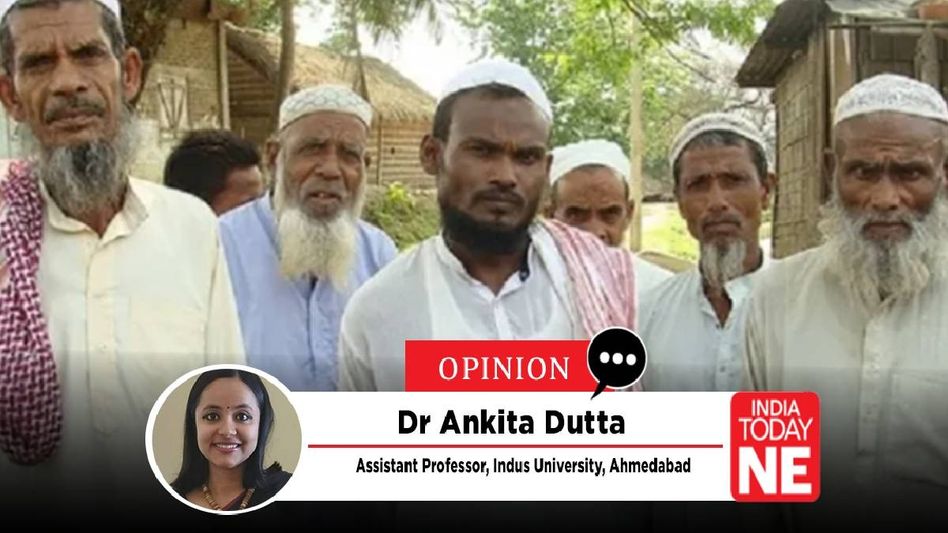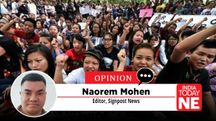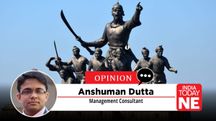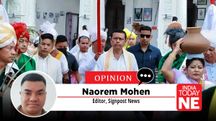Why is the Miya identity problematic?
People with vested interests from the so-called “intellectual” and “academic” fraternity across Bharat and the entire world somehow seem to be delighted by the emergence and acceptance of this identity by the immigrant Muslim population of Assam.
 Why is the Miya identity problematic?
Why is the Miya identity problematic?The question of Miya identity has been raised time and again in the socio-political discourse of Assam. Miya is a colloquial form of address used by most common men and women in Assam to refer to the immigrant-origin Bangladeshi Muslims. It is a commonplace reference used to describe their language, food habits and culture, which are very different from the native Assamese community. But, over the past few years, this same Miya identity is being celebrated by a certain section of people in Assam in the light of the increasing immigrant Muslim population in the state and its vastly changing demography.
People with vested interests from the so-called “intellectual” and “academic” fraternity across Bharat and the entire world somehow seem to be delighted by the emergence and acceptance of this identity by the immigrant Muslim population of Assam. This is indeed an important development that naturally raises one basic and fundamental question – What if this yearning for a separate identity someday result in a demand by this particular population of Miyas in Assam declaring themselves as a separate nation? Taking into account the history of the formation of Pakistan, we certainly cannot rule out such a possibility.
The glorification of a separate Miya identity implies a re-invention of Jinnah’s Two-Nation theory, by defaming the larger Assamese society both at the national and international platforms. People of this same society have had their own share of contributions in facilitating the upward economic mobility of the immigrant Muslims. We have employed their men as labourers in our fields and farms and we have also provided employment to their women by engaging them mostly in our homes as maidservants. But, they are now vouching for a separate micro-identity within the larger Assamese regional identity.
By doing this, they are implicitly supporting the creation of another separate nation within the Indian nation. Their claim that they have been facing suffering and humiliation in Assam is simply ridiculous because had it been so, then how have they managed to take part in India’s largest democratic exercise? Also, by virtue of the same democratic process, aren’t they becoming the representatives of their Miya community within the larger Assamese society since the time of Independence? Most importantly, their increasing numbers in each consecutive Census cannot be overlooked.
They have easy access to all Government facilities and schemes. So, what kind of suffering are they facing in Assam? Clearly, it is a well-crafted propaganda targeted against Assam and the Assamese society. They are able to own land, compete for Government jobs at par with the rest of the society, and even contest elections. So, why the espousal for a separate Miya identity now? It is nothing but victimhood politics that immigrant Muslims, in collusion with a Communist academia, have always been playing to garner as much sympathy as possible for their cause.
They have an extremely strong hold over the narrative, backed by a politically powerful lobby of authors and intellectuals, poets, human rights activists, NGO workers, etc. which has enabled them to internationalize this issue from time to time in different avatars, sometimes as Miya Kobita, sometimes as Miya Gaan, or the establishment of a separate Miya museum or even claiming a separate genre of Miya Bihu. This, they have been doing strategically to achieve a long-term objective; i.e. to first establish a separate identity of their own and then move towards a separate Miya nation in the near future.
The assertion of a separate Miya identity needs to be understood in the context of the long-harboured dream of a few Muslim leaders who wanted to make Assam an Islamic nation at the time of India’s Independence. It poses serious threats to the complex sub-regional matrix of the Assamese polity, because a separate branch of Miya poetry or Miya song or Miya Bihu in itself contains the seeds of separate nationhood that proudly disowns Bharat and a Bharatiya identity. Chief Minister Dr. Himanta Biswa Sarma has continuously tried to draw the attention of the larger Indian public to this problem.
His speeches on this subject in the recent sessions of the Assam Legislative Assembly were infused with a lively gusto that not only swayed the opinions of the youth but have also been able to convince others about the threat to the Assamese identity and the need for it to be protected. It might sound like a politically incorrect concern or even academically suicidal to talk about, but there is today a genuine sense of fear among the people of Assam – the fear of becoming a minority in one’s own land, and this has more to do with a community’s culture and civilization than religion.
There has been a continuous disappearance of non-Muslim tribes and communities from the border districts of Lower Assam. At a time when the issue of Islamic immigration has emerged as a serious issue for Governments in the West and their political paradigms, it is too naïve politically to not expect a reaction from the people of Assam against the problem. A separate Miya identity is the continuation of Jinnah’s Two-Nation theory – the guiding force of the Islamist political imagination. It also provides further fuel to the increasing Arabization of the immigrant Bangladeshi Muslim society in Assam.
The changing demographic character of Assam simply cannot be overlooked. But, the topic of a separate Miya identity keeps on repeating itself, for it is a common pattern in the Islamic worldview to raise separatist demands once the population of the Muslims crosses a certain threshold. In the modern times, a common pattern can be observed in the immigration of the Muslims from the Middle-Eastern countries, Syria specifically, towards Europe, and in the latter half of the last century when a majority of the Muslims migrated from the Indian subcontinent (India, Pakistan and Bangladesh) to the UK.
They initially came to these countries as victims of war, begging for food and shelter, while exploiting the ‘colonial guilt’ complex of the white-skinned people in Europe. They grew silently. But, once they crossed a population limit, they began asserting their rights. But, after acquiring these rights, their demands kept on increasing. H.V. Seshadri, in his famous book The Tragic Story of the Partition has elaborated upon this phenomenon witnessed in Islamic societies across the globe through numerous examples of Muslims first creating acrimony in their country of residence and then protesting on the ground of ‘discrimination’.
Protests soon transform into threats against the native population. In no time, they take to the streets and create a riot-like situation. This is the Islamic psyche of demanding more and more concessions from the Government, neatly and thoroughly explained by scholars like H.V. Seshadri and many other ex-Muslims as well. It has been expressed in public statements made at different times by Bangladesh’s founding father Sheikh Mujibur Rehman and Zulfikar Ali Bhutto of Pakistan. They have declared in the past that the economy of East Pakistan would remain incomplete without incorporating Assam into it.
After all, it was Jinnah’s Private Secretary Moinul Haque Choudhury, who had promised Jinnah that he would “present Assam to him on a silver platter”. At the time of the Sylhet referendum, the East Pakistanis had declared, “Silet lole bhoter jure, Axom lobo laathor bole” – meaning, “We have taken Sylhet via referendum, we will take Assam via the power of the stick.” In his book Eastern Pakistan: Its Population and Economics, Sheikh Mujibur Rehman even stated that the tribals of Assam were not only non-Hindus but were also unfit for a civilised life.
Muslims first infiltrate and invade a society from within and then make that society diseased by their very presence. Once they achieve their population target, they begin asserting a separate identity for themselves, based upon Islamic theological injunctions. It has become all the more prominent especially after the downfall of the Islamic State of Iraq and Syria (ISIS) and their so-called “Caliphate” in the Middle-East. In this regard, M.D. Deshpande in his book on the Gujarat Riots has explained the chronology of riots with reference to Gujarat that began from 1750 onwards.
Committing riots ensure Muslims a sense of security. They use it as a tool for area-domination that allows them to keep the population of the non-Muslims, Hindus in particular, under check and help them grab a particular piece of territory inch by inch. Once the Mughal Empire disintegrated, Muslims lacked a central authority. So, keeping the non-Muslims under constant threat by fomenting a cycle of violence from time to time was a tried-and-tested strategy used by them to maintain intact their area dominance and expand their influence simultaneously to other areas. Islamic societies simply do not relent.
They change their strategies depending upon the changing times in order to achieve their goal. The same holds true for Miya identity as well, which keeps on manifesting itself in different versions. Interestingly, following the crisis in neighbouring Bangladesh after the ouster of Sheikh Hasina and the unending violence against Hindus, this same Miya identity rejuvenated itself as Miya Gaan. Emboldened by their already increasing numbers, they not only asserted their Islamic identity again but also dared to threaten the larger Assamese society, a major section of which is yet not familiar with the tactics of the Islamists.
Similar to Kashmir, in the garb of a separate Miya identity and so-called “discrimination” and “persecution” faced by the Miyas in Assam, Islamists are strategically preparing the ground for another Kashmir in Assam with active support from their international mercenaries. It is a recipe for disaster that is essentially trying to legitimize Miya as an ethno-cultural identity so that under the Constitution of India, they can demand a separate state for themselves within the Indian Union in the name of ‘ethnicity’ or special status akin to Kashmir. It has always happened in the past and is happening across the world now.
(The author can be reached at ankitaindusuniversity@gmail.com)
Copyright©2025 Living Media India Limited. For reprint rights: Syndications Today









